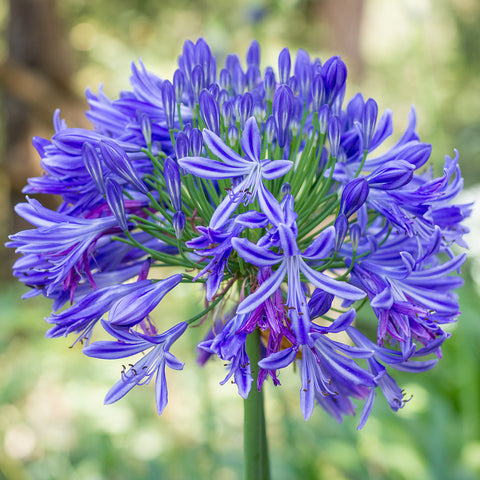Grasping the Art of Agapanthus Care: Vital Actions for Healthy Growth and Lively Flowers
In the world of gardening, the cultivation of agapanthus stands as a satisfying venture for those that seek to support these stylish flowering plants. From picking the right selection to mastering pruning strategies, the trip in the direction of cultivating prospering agapanthus plants is multifaceted and holds the essential to unlocking the complete potential of these agricultural treasures.

Choosing the Right Agapanthus Range

When picking the best Agapanthus variety for your yard, think about aspects such as climate viability, blossom shade, and growth practice. Furthermore, think about the climate in your region to make sure the Agapanthus variety you choose can grow in your certain conditions. Understanding the growth habit of various Agapanthus selections is vital for proper positioning within your garden.
Perfect Growing Conditions
Taking into consideration the ideal environmental demands is crucial for successful Agapanthus farming. Agapanthus plants are delicate to chilly temperature levels and should be shielded from frost during winter season months.
To make certain healthy growth and vibrant blossoms, plant Agapanthus light bulbs at a depth of regarding 2-4 inches and space them 8-12 inches apart. Including raw material, such as garden compost, to the soil can improve water drainage and fertility, promoting durable root development. Mulching around the base of the plants assists retain wetness and subdues weed growth. Regular watering is important, specifically throughout the growing period, to maintain the soil regularly wet yet not soaked.
Watering and Feeding Tips
Preserving appropriate moisture degrees and providing vital nutrients are vital elements in the care regimen for Agapanthus plants. It is vital to strike an equilibrium when it comes to watering Agapanthus. These plants like consistently wet soil but are at risk to root rot if overwatered. Throughout the growing period, water deeply as soon as a week, making certain the soil is well-draining to stop waterlogging. In hotter climates or throughout durations of dry spell, more constant watering might be necessary to keep the dirt uniformly moist. Nevertheless, lower watering in the wintertime to stop waterlogged problems.
Feeding Agapanthus is essential for advertising healthy and balanced development and respected flowers. Apply a well balanced fertilizer, such as a 10-10-10 formula, in the early springtime as new growth emerges. By complying with these watering and feeding tips, you can ensure click for more your Agapanthus plants flourish and generate dynamic, durable blooms.
Pruning Methods for Agapanthus
Pruning Agapanthus plants at the appropriate times and with proper strategies is critical for keeping their health and wellness and advertising optimum growth and blooming. The suitable time to trim Agapanthus remains in late wintertime or very early spring before new growth emerges. Beginning by eliminating any type of yellowing or dead leaves near the base of the plant. Cut them as close to the ground as feasible without damaging the arising shoots.
For flowered stems, wait up until the flowers have withered and afterwards cut them back to the base. This not only cleans up the plant's appearance yet additionally motivates the advancement of new flower buds. Deadheading invested flowers can additionally redirect the plant's energy into generating more blooms instead of establishing seeds. Nevertheless, if you intend to gather seeds for breeding, leave some flowers to fully grown and browse around this web-site dry on the plant.
Keep in mind to utilize clean, sharp tools to make specific cuts and reduce the threat of introducing diseases. Agapanthus. Normal pruning will assist maintain your Agapanthus looking healthy and balanced and neat while ensuring a plentiful display screen of gorgeous blossoms
Taking Care Of Common Pests and Diseases
After making certain correct trimming strategies for Agapanthus, it is vital to attend to common bugs and illness that can impact the health and wellness and vigor of these plants. Agapanthus plants are generally sturdy but can still come down with certain concerns. One typical bug that affects Agapanthus is the Agapanthus gall midge. This little, orange fly lays its eggs in the foliage, leading to distorted growth and flower buds that fall short to open. To combat this insect, trim and destroy any kind of damaged plant parts and think about making use of insecticidal soap.
An additional usual concern is fungal fallen leave area, which presents as dark sores on the leaves. To prevent fungal conditions, guarantee excellent air flow around the plants, prevent above watering, and remove any infected leaves quickly. Additionally, Agapanthus plants can struggle with root rot if they are grown in poorly draining dirt. To avoid this, plant Agapanthus in well-draining soil and stay clear of overwatering. By being watchful and taking prompt activity against parasites and illness, you can assist your Agapanthus plants prosper and produce dynamic flowers.

Verdict
To conclude, understanding the art of agapanthus care entails selecting the ideal variety, supplying excellent growing conditions, appropriate watering and feeding, ideal pruning methods, and addressing common insects and diseases. By complying with these essential steps, you can make sure healthy development and dynamic blossoms for your agapanthus plants. Keep in mind to routinely check and keep discover this your plants to promote their overall health and durability.
To make certain healthy growth and lively flowers, plant Agapanthus bulbs at a deepness of about 2-4 inches and room them 8-12 inches apart. By complying with these watering and fertilizing tips, you can guarantee your Agapanthus plants flourish and generate lively, lasting flowers.
One usual parasite that impacts Agapanthus is the Agapanthus gall midget. Furthermore, Agapanthus plants can suffer from root rot if they are planted in badly draining pipes soil. By adhering to these crucial steps, you can guarantee healthy development and lively flowers for your agapanthus plants.